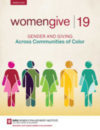“Women Give 2019 affirms that women are generous—all women, across racial and ethnic groups.”
What is this Report?

This report is the “first to explore the intersection of race, gender, and giving.” The report does literature reviews about race and philanthropy and the impact of gender and philanthropy. The report aims to bring all three ideas together and better understand how race and gender impact giving overall, where gifts are going, impact on volunteering and the influence of wealth on both giving and volunteerism.
What are key findings from the article?
- Race does not have a significant impact on the amounts given to charity. What does have a big impact on gift amounts are income, wealth, education and other factors.
- Differences in giving between genders is consistent across the race. Across all racial groups, the best performing donors ranked in order are (1) married or cohabitating couples, (2) single women, and (3) single men.
- Their interviews with six female philanthropists affirmed that women view philanthropy as more than just giving – the idea of time, treasure and talent came up. Giving back was an important consideration for these philanthropists.
- There are important differences between how different communities give and volunteer.
- “African American donors may prefer to give informally or to their house of worship; these donors also often focus on civil rights and social justice.
- Hispanic/Latino donors also appear to give more informally, particularly to members of their family and extended networks.
- While Asian American donors may be the most diverse group, they largely are interested in an entrepreneurial approach to giving, and focus on the areas of education and faith.”
- There were differences in the percentages of each population that formally volunteered. In HNW populations:
- 60.2% of Hispanic populations are volunteering
- 48.3% of White Populations
- 45.4% of African American populations
- 38.9% of Asian American populations.
What can I do as a result?
- Identify the single women. Have you run a report to identify how many single, female donors you have? These are a high performing donor group. If you have a large group of single, female donors (or you want more), consider ways you can reach out to them to discover how they view your organization and what would help them deepen their engagement.
- Engage volunteers, especially Hispanics. The Women Give studies continue to demonstrate that women volunteer before “trusting” organizations with their donations and networks. How can you engage women, in formal and informal volunteer opportunities? Decide early on if you want any new engagement program you develop to have fundraising goals.
- Income is the biggest indicator of major giving. Women and racial minorities are consistently undervalued in our traditional major gift identification practices. Bridge the gap by appending occupational information and qualifying based on high-income professions. You’ll still miss good prospects, but it’s a start!
Additional Resources
- Women Give: Gender and Giving Across Communities of Color. IUPI Women’s Philanthropy Institute, Lilly Family School of Philanthropy. March 2019.
- Loehr, Kathleen. Gender Matters: A Guide to Growing Women’s Philanthropy. CASE 2018.
- Bryner, Sarah. “Race, Gender, and Money in Politics: Campaign Finance and Federal Candidates in the 2018 Midterms.” US 2050 Research Projects from Peter G. Peterson Foundation. March 21, 2019.
Source Notes:
- The report uses data from the Philanthropy Panel Study (PPS) from 2015, the most recent year of data. The PPS data had 5,954 households with the following numbers of people identifying as racial groups: 627 African-American, 105 Asian American, 636 as Hispanic, 4586 as White non-Hispanic.
- The report also used data from the 2018 US Trust Study of High Net Worth Philanthropy that had 1,573 households with the following breakdown of self-identifying racial groups: 97 African-American, 134 Asian American, 100 Hispanic, and 1,231 White non-Hispanic. They also did 6 interviews with philanthropic women.